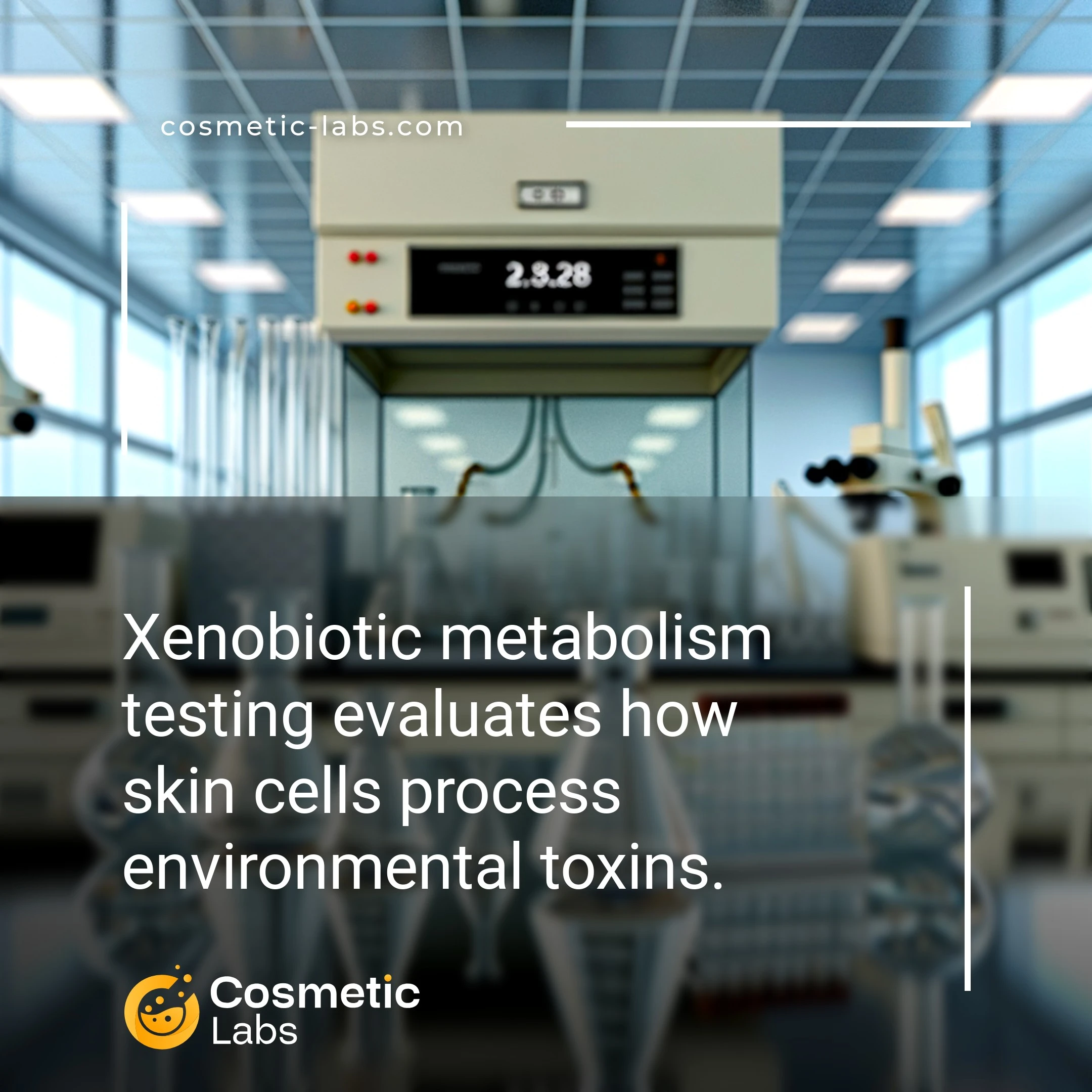Xenobiotic Metabolism Testing for Pollutant Protection Claims

What is Xenobiotic metabolism?
Xenobiotic metabolism testing for pollutant protection evaluates how skin cells process and eliminate foreign chemicals like environmental toxins, heavy metals, and synthetic compounds. Our partner labs use in vitro enzyme assays and cellular detoxification pathways to measure your formulation’s ability to enhance the skin’s natural defense mechanisms against urban pollution, cigarette smoke, and industrial contaminants—helping you develop products that actively support cellular cleanup processes.
Why do you need this service?
Cosmetic labs use xenobiotic metabolism testing to validate anti-pollution claims for urban skincare products, measuring how effectively formulations help skin cells process environmental toxins like particulate matter and heavy metals. This testing proves your product’s detoxification benefits with quantifiable data, supporting marketing claims while meeting regulatory requirements for pollution protection cosmetics targeting city-dwelling consumers.
Who provides Xenobiotic metabolism services?
All cosmetic labs providing Xenobiotic metabolism services
There is no company providing these services at the moment.
Xenobiotic Metabolism Testing for Pollutant Protection
Xenobiotic metabolism testing evaluates how skin cells process and eliminate environmental toxins, providing data that validates your product’s protective claims. This cellular-level analysis measures detoxification enzyme activity and metabolic pathways that help skin defend against pollutants like heavy metals, particulates, and chemical contaminants.
Cellular Detoxification Pathway Analysis
Labs measure key phase I and phase II detoxification enzymes including cytochrome P450, glutathione S-transferase, and UDP-glucuronosyltransferase. These tests show how your formulation affects cellular metabolism at the molecular level. Testing protocols typically run 24-72 hours using human keratinocyte cultures exposed to controlled pollutant concentrations.
Results include:
- Enzyme activity levels before and after treatment
- Metabolite formation rates
- Cellular viability under pollutant stress
- Antioxidant capacity measurements
Pollutant Clearance and Protection Metrics
Testing services evaluate how effectively your ingredients help skin eliminate specific pollutants. Labs expose skin models to urban dust, diesel exhaust particles, or heavy metals, then measure clearance rates and cellular damage markers. This data supports marketing claims about pollution defense and detoxification benefits.
Standard measurements track intracellular pollutant accumulation, inflammatory response markers, and barrier function recovery. Testing typically requires 2-3 weeks for complete metabolic profiling. Connect with specialized labs on our platform to discuss xenobiotic metabolism testing protocols tailored to your product’s target pollutants and active ingredients.
Practical Applications of Xenobiotic Metabolism Testing for Pollutant Protection
Xenobiotic metabolism testing applications enable beauty brands to validate their products’ ability to enhance skin’s natural detoxification processes against environmental pollutants.
Anti-Pollution Skincare Product Development
Labs evaluate how cosmetic formulations support the skin’s cytochrome P450 enzyme systems and phase II conjugation pathways. Testing protocols measure ingredient effects on glutathione S-transferase activity and UDP-glucuronosyltransferase expression in keratinocyte cultures exposed to PM2.5 particles, ozone, and heavy metals.
Results quantify detoxification enzyme upregulation percentages and pollutant clearance rates. Brands use this data to substantiate claims about urban defense serums, anti-pollution moisturizers, and protective barrier creams that actively support cellular detox mechanisms.
Ingredient Screening for Detoxification Enhancement
Testing services screen raw materials for their ability to modulate xenobiotic-metabolizing enzymes in skin cells. Labs assess botanical extracts, peptides, and synthetic compounds using gene expression analysis and enzyme activity assays.
Protocols measure metabolic pathway activation through qPCR analysis of CYP1A1, GSTA1, and NQO1 gene expression. This screening identifies ingredients that boost the skin’s natural ability to process environmental toxins, helping formulators select actives for pollution-defense products.
| Testing Parameter | Measurement Method | Typical Results |
|---|---|---|
| Phase I Enzyme Activity | CYP450 fluorometric assay | 15-40% increase |
| Phase II Conjugation | GST activity colorimetric | 20-60% upregulation |
| Antioxidant Response | Nrf2 pathway analysis | 2-5 fold activation |
| Pollutant Clearance | LC-MS/MS quantification | 30-70% reduction |
Connect with specialized cosmetic labs on our platform to access xenobiotic metabolism testing services that validate your pollution-protection formulations with precise, actionable data.
